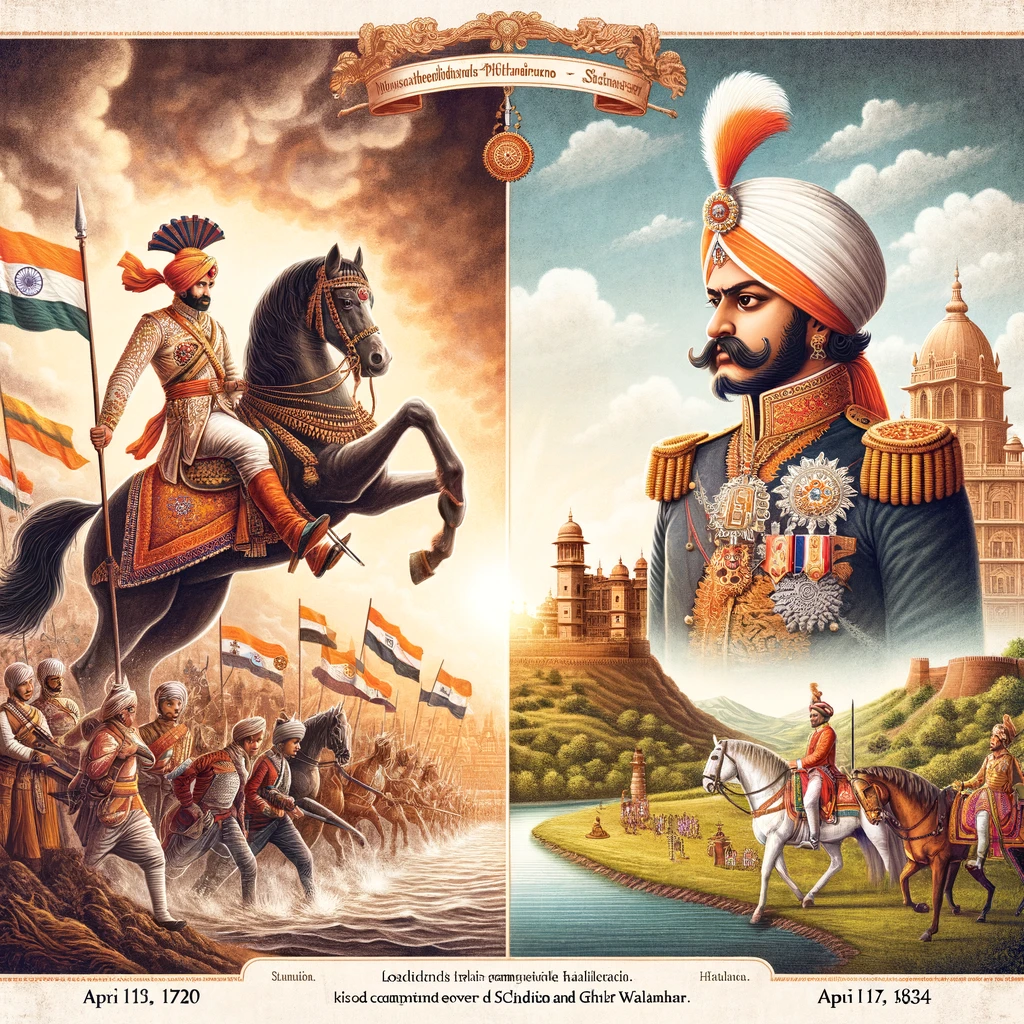On This Day 17 April 2024 Wednesday
On This Day 17 April, Sam Vikram: 2081 Purnimanta Mass: Chaitra Paksha: Tithi: Sukla Paksha Dashami – Apr 17 03:14 PM – Apr 18 05:31 PM, let us have a quick look of the events and anniversaries of India and the world
 Panchang /
Panchang /
Shaka Samvat: 1946
Purnimanta: Chaitra
Tithi: Sukla Paksha Dashami – Apr 17 03:14 PM – Apr 18 05:31 PM
On This Day
Festivals Today: Shree Mahaataara Jayantee, Raam Navamee, Svaamee Naaraayan Jayantee
Festials Tomorrow:
Day Today:
Day Tomorrow:
Yoga:
Soola – Apr 16 11:16 PM – Apr 17 11:50 PM
Ganda – Apr 17 11:50 PM – Apr 19 12:43 AM
Karana:
Kaulava – Apr 17 02:15 AM – Apr 17 03:14 PM
Taitila – Apr 17 03:14 PM – Apr 18 04:20 AM
Garija – Apr 18 04:20 AM – Apr 18 05:32 PM”
Sunrise: 5:57
Sunset: 18:44
Moonrise: 13:04
Moonset: 2:58
 Auspicious Time
Auspicious Time
Abhijit Muhurat – Nil
Amrit Kaal – None
Brahma Muhurat – 04:19 AM – 05:07 AM
![]() Inauspicious Time
Inauspicious Time
Rahu – 12:20 PM – 1:56 PM
Yamaganda – 7:32 AM – 9:08 AM
Gulika – 10:44 AM – 12:20 PM
Dur Muhurat – 11:54 AM – 12:46 PM
Varjyam – 07:29 PM – 09:16 PM
Information Source: https://www.prokerala.com/
Today / आज
Freedom Fighters sacrificed- At Least: 10
Major Historical Events
1. Leadership Commencement of Peshwa Bajirao I
- Date & Context: Peshwa Bajirao I ascended to the position of Peshwa (Prime Minister) of the Maratha Empire on April 17, 1720.
- Significance: His appointment marked a turning point in Maratha history. Bajirao I is renowned for his military tactics and expansionist policies, which significantly extended the Maratha Empire’s influence in India. He is credited with pioneering the use of rapid troop movements and cavalry attacks.
- Contributions: Under his leadership, the Marathas became the dominant power in much of India. His campaigns across the north expanded the Maratha influence beyond the Deccan Plateau.
2. Leadership Commencement of Harirao Vitthojirao Holkar
- Date & Context: Harirao Vitthojirao Holkar started his leadership role over the regions of Scindia and Gwalior State on April 17, 1834.
- Role in History: As a lesser-known figure compared to other Maratha leaders, Harirao played a significant role in maintaining Maratha influence in central India during a period when the power dynamics were shifting due to the rise of the British Raj.
- Legacy: His tenure is marked by attempts to stabilize the region under Maratha control amidst growing pressures from British expansion.
3. India’s Space Milestone: SLV-3 Rocket Launch
- Date & Achievement: On April 17, 1983, India achieved a significant milestone in its space history by successfully launching the SLV-3 (Satellite Launch Vehicle) rocket.
- Impact: This launch marked India’s entry into the space age, establishing it as a contender in global space technology. The SLV-3 was developed by the Indian Space Research Organisation (ISRO) and was pivotal in demonstrating India’s capability to deploy satellites into orbit.
- Future Influence: This success laid the groundwork for future advancements in Indian space missions, including lunar and Mars explorations.
4. Prankote Massacre
- Date & Event: On April 17, 1998, the Prankote massacre occurred in the Doda district of Jammu and Kashmir where 26 Hindus were tragically killed.
- Background: This massacre was part of the larger conflict in the region involving separatist insurgents. The violence was aimed at creating terror and displacing populations.
- Consequences: The massacre led to significant outcry and further complicated the already tense situation in Jammu and Kashmir, affecting communal harmony and leading to increased security measures in the region.
History in Brief On This Day
- Bay of Pigs Invasion: On April 17, 1961, a U.S.-backed attempt to overthrow Cuban Premier Fidel Castro failed, known as the Bay of Pigs fiasco.
- End of the Cambodian Civil War: April 17, 1975, marks the end of the Cambodian Civil War with the victory of the Khmer Rouge and the beginning of the Cambodian genocide.
- Train Disaster in India: A gas explosion on a passenger train in Kumrahar, India, on April 17, 1990, resulted in 80 fatalities.
- Bangalore Blast: On April 17, 2013, a terrorist attack in Bangalore, India, at Bengaluru resulted in 16 injuries.
- Death of Sarvepalli Radhakrishnan: Sarvepalli Radhakrishnan, a distinguished Indian philosopher and statesman, passed away on April 17, 1975, in Thiruttani, Tamil Nadu, India.
Anniversaries On This Day
- Majid Majidi – Renowned Filmmaker: Celebrated Iranian filmmaker Majid Majidi was born on April 17, 1959.
- Geet Sethi – Snooker Legend: Geet Sethi, an acclaimed snooker player, was born on April 17, 1961, in Delhi.
- Dinesh Mongia – Cricket Star: Indian cricketer Dinesh Mongia was born on April 17, 1977, in Chandigarh.
- Siddharth Narayan – Film Industry Luminary: Siddharth Narayan, a prominent figure in Indian cinema, celebrates his birthday on April 17, 1979.
- Santhi Soundarajan – Athletics Icon: Santhi Soundarajan, a middle-distance runner from India, was born on April 17, 1981, in Pudukkottai district.
- Death of Wong Fei-hung: Wong Fei-hung, a legendary Chinese martial artist, passed away on April 17, 1925, in Foshan, China.
- Börje Salming – Ice Hockey Hero: Swedish ice hockey player Börje Salming was born on April 17, 1951, in Kiruna, Sweden.
- Roddy Piper – Wrestling Star: WWE wrestler Roddy Piper was born on April 17, 1954, in Saskatoon, Canada.
- Sean Bean – Acclaimed Actor: British actor Sean Bean was born on April 17, 1959.
- Boomer Esiason – Football and Broadcasting Figure: Boomer Esiason, known for his roles in American football and as a sportscaster, was born on April 17, 1961, in West Islip, New York, USA.
- Romain Grosjean – Motorsports Competitor: F1 driver Romain Grosjean was born on April 17, 1986, in Geneva, Switzerland.
- Death of Chyna: WWE wrestler and bodybuilder Chyna passed away on April 17, 2016, in Rochester, New York, USA.
On This Day 17 April: Reflections on India’s Freedom Struggle Events
The date April 17 holds significant historical relevance in the context of India’s protracted struggle for freedom from British colonial rule. Throughout this period, numerous events occurred which not only shaped the trajectory of the Indian independence movement but also highlighted the profound sacrifices made by its participants. This essay delves into key episodes from this day that illustrate the courageous yet tragic actions of those who fought against colonial oppression.
1919: The Aftermath of the Rowlatt Act Demonstrations in Delhi
Context of the Rowlatt Act
In early 1919, the British colonial government enacted the Rowlatt Act, which empowered authorities to imprison suspected revolutionaries without trial. This legislation prompted widespread unrest across India, leading to significant demonstrations.
Violence on March 30 and April 17, 1919
On March 30, 1919, British troops, under orders from Mr. Currie, the Additional District Magistrate, opened fire on unarmed demonstrators at Delhi Railway Station and near the Clock Tower, resulting in sixty casualties. The atmosphere of tension and repression continued to escalate, leading to another critical incident on April 17, 1919. On this day, a police picket again opened fire on demonstrators, injuring 18 and tragically leading to the deaths of two individuals.
Personal Sacrifices
Among those who suffered on these days were individuals like Chheda, Din Mohammad, Gopinath, Hashmat Ullah Khan, Kamla Dutt, Ram Kishan, and Ram Singh. Each of these individuals sustained injuries in the firings, and each later succumbed to their wounds. These martyrs were not merely statistics; they were individuals with families, aspirations, and a shared dream of an independent India.
1858: The Sentencing of Zorawur Singh
On April 17, 1858, during the heat of the 1857 Uprising, Zorawur Singh, a former soldier of the English East India Company, was sentenced to life transportation. Singh had abandoned his service to join the rebels, a courageous but perilous decision that highlighted the widespread dissent within the ranks of the colonial armed forces. His eventual capture and harsh sentencing underlined the brutal reprisals often faced by those who dared to defy the colonial regime.
1923 and 1924: The Continued Struggle
Santosh Kumar Mitra and Babu Santa Singh
The 1920s saw continued efforts against British authority, marked by both peaceful protests and militant actions. On April 17, 1923, Babu Santa Singh engaged in actions that led to the murder of a colonial loyalist, reflecting the intense, sometimes violent, nature of the resistance. In contrast, on April 17, 1924, Santosh Kumar Mitra was acquitted under regulation but remained under scrutiny, illustrating the ongoing struggle between maintaining public order and suppressing revolutionary activities.
Reflecting on Courage and Sacrifice
“On this day” each year, we remember the profound courage and the grievous sacrifices made by countless individuals in the pursuit of India’s freedom. These events, while marked by tragedy and loss, also underscore the resilient spirit and collective resolve of those who fought for independence. Each story, each life lost, contributes to our understanding of the immense price paid for the liberties enjoyed today. Through these reflections, we honor the memory of all who stood against colonial domination, whose valiant efforts eventually led to the realization of a sovereign nation.
Feature Image: The image visually represents two pivotal figures in Maratha history. On the left, Peshwa Bajirao I is depicted as a dynamic military leader, mounted on a horse, wearing traditional Maratha warrior attire, which signifies his role in the expansion of the Maratha Empire. His posture and expression convey determination and strategic insight, reflecting his military prowess. On the right, Harirao Vitthojirao Holkar stands authoritatively in a landscape that symbolizes central India. He is dressed in regal Maratha clothing, indicating his leadership over the Scindia and Gwalior State. The background blends elements from the 18th and 19th centuries, with architectural and natural features that contextualize their eras and regions. (Click here to see image)
If you want to buy books on the subject please visit this page: https://www.amazon.in/.
Please note that if you buy anyhing using this link we will get some affiliate commission. If you want to support us, please use this link in case you need to buy goods from https://www.amazon.in/

Your articles are extremely helpful to me. May I ask for more information?
Fantastic goods from you, man. I’ve bear in mind your stuff prior to and you are simply extremely great. I actually like what you’ve got here, certainly like what you are stating and the way through which you are saying it. You make it entertaining and you still take care of to stay it wise. I can’t wait to read much more from you. That is really a tremendous site.
I have not checked in here for a while as I thought it was getting boring, but the last several posts are great quality so I guess I will add you back to my everyday bloglist. You deserve it my friend